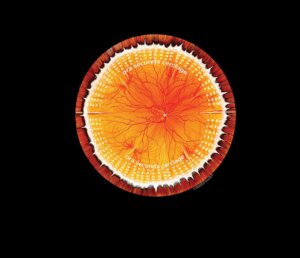
The technology to prevent retinal detachments has been around for decades, but recent studies by the Birmingham-based Helen Keller Foundation help prove that non-invasive laser treatments can reliably prevent this cause for blindness.
Retinal detachment is the leading cause of sudden sight loss in aging eyes, causing permanent blindness if not effectively treated. It also remains the most common acute ocular emergency that eye doctors see every week, says Dr. Robert Morris, HFK co-founder and president.

“Most people who have a retinal detachment didn’t fall down the stairs or anything — it just happens out of the blue in the normal course of their daily lives,” he says. “So, it’s pretty much a shock.”
Retinal detachments are most common in adults aged 50 and over, but detachments at all ages frequently share the same origins — peripheral retinal tears, enabling fluid to seep beneath the retina, floating it away from the eyewall. Tears are caused by movements of the eye’s vitreous gel that, with age, becomes more mobile inside the eye.
Doctors can repair the tear, but not everyone gets their full vision back, says Morris, adding, “It’s very important and helpful to stop a retinal detachment before it begins.”
The difficult part in testing the effectiveness of the prevention treatment is figuring out who will be affected, says Morris, an ophthalmic surgeon who also serves as the president of Retina Specialists of Alabama and as president of the International Society of Ocular Trauma. And while there are some elevated risk factors for retinal detachment, including family history and cataract surgery, there is no way of knowing who it will affect and when, he explains.
“Here’s where it gets interesting,” he says. “We do know that little kids and teenagers with Stickler syndrome, a rare, inherited disease in which patients are more prone to detached retinas from birth onward. And we know that they have a 65% detachment rate in their lifetime, with half of those occurring before they are 20 years old and 80% of the retinal detachments occurring in both eyes. These are very difficult to fix at that point, so there’s a lot of blindness and legal blindness in generation after generation of patients with Stickler syndrome.”
“By identifying these children most at risk for retinal detachment and doing an encircling bonding treatment to reinforce the retina’s attachment, then seeing the detachment rate plummet to almost zero — well, you’ve pretty well proven your point,” says Morris.
A group of doctors in Cambridge, England, started doing a 360-degree retinal bonding treatment in 1978 and reported its long-term effectiveness in 2014. “But here’s the problem,” says Morris. “What they used is called freeze treatment, or cryotherapy, and it’s another way to create bonding of the retina to the eye wall. But the freeze treatment has been pretty much abandoned by the vast majority of retina doctors around the world in favor of laser treatment, which is less invasive and causes fewer complications.”
So, the Hellen Keller Foundation compared the laser and freeze bonding treatments and found both to be equally effective. This emerging proof was recently published in the Journal of Clinical Ophthalmology.
“It took 25 years and many investigators to adequately prove that bonding the entire peripheral retina to the eye wall with lasers could reliably prevent most tears that cause blinding retinal detachments,” says Morris. “We ‘connected the dots,’ showing that this research had finally reached the level of strong evidence.”
Focused Research
While the Helen Keller Foundation remains relatively small, says Morris, it tries to allocate its resources to best address problems that make the biggest difference in patient care.
“We don’t have the money or the staff or the labs to do the basic science work, which sometimes can take 20-30 years to pay off,” says Morris. “We spend about $500,000 per year, while many other vision research organizations spend tens of millions per year.”
Most HFK research physicians donate their time and tend to concentrate on clinical research, which means analyzing what kinds of treatments have been and have the potential to be the most effective.
“We stand on the shoulders of giants,” says Morris. By taking a methodical look at research already completed by other organizations around the world, HKF researchers can best use their time in finding solutions and targeting problems that can be made better through the use of current knowledge and technology.
Three reports from the United States and England during 2022 have since confirmed the safety and efficacy of encircling laser prevention in Stickler syndrome.
No prevention treatment has been through a clinical trial, says Morris, but that should not be a deterrent for doctors or patients considering the treatment. “Clinical trials are wonderful, but they are very costly — costing millions of dollars — and can take a long time — many years,” he adds. “But strong proof can still come from retrospective studies that have been analyzed well and have a large enough number of patients — such as what we’ve done with preventing retinal detachments.”
And while there is still no foolproof way to determine who may be at the greatest risk for retinal detachment in the older population — “that’s still a work in progress,” says Morris, “if a doctor is in an exam room with a patient who already has had a retinal detachment, that patient is at a higher risk to have another detachment in their good eye — we don’t tell the doctors who to use it on, but it is now an option for patients determined to be at high risk. We now know that safe and effective prevention is possible, and that it is achieved by carefully applying laser light to the peripheral retina, 360 degrees, with no incision needed.”
“Our conclusions are subject to continuing medical peer review,” says Morris. “But the ultimate judgment will be made by each appropriately informed patient who faces a high risk of retinal detachment and chooses preventive laser treatment or continued observation. And that’s how it should be.”

Latest breakthroughs for Helen Keller Foundation:
Proof of preventing retinal detachment with laser treatments is the latest breakthrough for the Helen Keller Foundation for Research and Education, founded in 1988. Other accomplishments include:
- Created a technique (ILM removal) that revolutionized surgery on the macula, the human center of vision, now used worldwide
- Developed the Birmingham Eye Trauma Terminology (BETT), standardizing the language for ocular trauma used worldwide
- Proved that the recently injured eye with no light perception (NLP) can often be restored to useful vision instead of being abandoned or removed
- Defined the disease of Degenerative Vitreous Syndrome (extensive floaters) describing a safe surgical technique for its treatment and earning the Buckler Award for best video from the American Society of Retina Specialists in 2007 (see www.FloaterStories.com)
- Published a new treatment paradigm “Complete and Early Vitrectomy for Endophthalmitis” (CEVE) that improved salvage of reading vision by 50% in eyes suffering severe infection after cataract surgery
Jennifer G. Williams is a Hartselle-based freelance contributor to Business Alabama.
This article appears in the July 2023 issue of Business Alabama.



